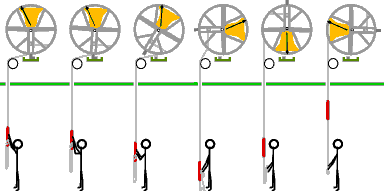The Bells Are Ringing
Last updated on:
19-October-2023
Top | Finding out about ringing | Reasons for ringing | English style ringing | What it sounds like | Other ringing styles
Bells are among the loudest and most majestic musical instruments. They can be heard far and wide. When you hear bells ringing do you know why they are ringing? This page may help you to find out.
 This page is mainly about English style bellringing, a unique way of ringing bells that evolved over 400 years ago and is currently practised by around 40,000 skilled bellringers worldwide. Ringing like this is mainly practised in England and in other parts of the English speaking world, see map.
This page is mainly about English style bellringing, a unique way of ringing bells that evolved over 400 years ago and is currently practised by around 40,000 skilled bellringers worldwide. Ringing like this is mainly practised in England and in other parts of the English speaking world, see map.
Over 5,000 towers worldwide have bells hung for English style ringing. Most of them are in churches, but a couple of hundred are in secular buildings, or former churches that have since been converted to other uses. You can search for details of any ringing tower in the Dove database.
For ringing other than English style see: What style of ringing
Finding out about ringing
In the long term we hope that this page may allow you to enter where you are and will then direct you to information about ringing performances that are near to you, but that is not yet possible. In the meanwhile there are other ways that you may be able to find out about the ringing that you hear:
There are often details outside the church – on a notice board, in the porch or by the by the tower entrance.
There may be an extra notice outside during a special performance (why, what and for how long).
There may be a tower website. Try searching for the name of the church and town with ‘bell’ and ’ringing’ in your search.
Most ringing societies have a website. They cover the UK other countries with English style ringing. Most have contact details (and web links) for towers in their area. If you can’t contact the tower try the secretary of the local society (or district).
There is a list of affiliated ringing societies.
English style ringing
English style ringing is 'full circle ringing' (where the bells swing through a full 360°). It is heard in England, the rest of the British Isles, the Commonwealth and the USA. The bells form a diatonic scale, with 6 or 8 being most common, but rings of 4, 5,10 & 12 bells are quite widespread, and a few towers have 14 or 16 bells. (Image courtesy of Fortran Friends)
 All towers with bells hung for English style ringing are listed in Dove’s Guide.
All towers with bells hung for English style ringing are listed in Dove’s Guide.
What it sounds like
The bells are rung in orderly sequences with a nominally constant rhythm. Each bell strikes roughly every two seconds (so with six bells you hear~3 blows per second, with eight bells there will be ~4 blows per second, and so on).
There are several distinct audible patterns of English style ringing:
| |
Description |
Listen / watch |
| Rounds |
The sequence of notes cascades repeatedly down the scale. Ringing starts and ends with Rounds. |
Rounds on 8 bells |
| Called changes |
The sequence of notes changes periodically. |
|
| Method ringing |
The sequence of notes changes all the time. |
On 12 bells, showing bells from above
On 6 bells, showing ringers in action |
| Raising in peal |
(At start of session) ringing in sequence down the scale and gets progressively slower over a few minutes. Takes bells from safe position (mouth-down) to to the mouth-up ready e position, by swinging them through progressively larger angles, position ready for use |
Raising in peal (8 bells) |
| Lowering in peal |
(At end of session) reverse of above to return bells to their safe position. The ringing gets quicker over several minutes and then stops after a pause and one final sequence. |
Lowering in peal (8 bells) |
| Half muffled ringing |
Alternate sequences are loud and soft. A solemn, dignified sound used for occasions like remembrance and funerals. |
Half muffled ringing |
| Devon style ringing |
Specialised style of ringing heard mainly in Devon. The ringing doesn't have the characteristic pause every other sequence that is heard in most English style ringing. Performances normally include raising in peal, ringing called changes and then lowering in peal, without stopping. |
North Devon Bellringing Mashup |
As well as hearing bells ringing in a tower, you may occasionally see them being rung outside in a mobile belfry. Listen / watch .
In English churches a single bell is often chimed for a few minutes before a service, either because they do not have a ring of English style bells or because for that service there are no bellringers present with the skills for full circle ringing. If you hear a single bell being rung over an extended period with occasional stops and starts it may be a novice ringer being trained. Normally the bells are silenced or quietened for such training, but not always.
For more information about English style ringing, see Discover Bellringing . Central Council fo Church Bell Ringers Here is some typical English style ringing
Reasons for ringing
English style ringing is either:
General ringing – Several short pieces last a few minutes each with gaps in between. There are normally more ringers than bells at such sessions, with ringers taking turns to ring.
A special performance – A a long period of continuous ringing. Typical lengths are: Quarter peal 45 minutes, Date touch 1 hour 15 minutes, Peal 3 hours. The same ringer rings each bell throughout.
Bells are rung for many reasons – routine or special, sacred or secular. Here are the most common:
| Reason |
Description |
Typical times |
Typical duration |
Comment |
| Regular church services |
Ringing before one or more service each Sunday |
Varies between churches. Morning is more common |
20 - 60 minutes |
May not be every week |
| Special church services |
Ringing before other occasional services |
May be any time |
As above |
Christmas and some other festivals that fall midweek |
| Weddings |
Ringing after (and sometimes before) a church wedding. |
During the day. Saturday more common. Summer more common |
15 - 30 minutes |
May be several a day at popular churches in summer. |
| National or local event |
Ringing to mark important events. General ringing or special performance. (See above) |
Any time. More likely evening or weekend |
Varies |
May be coordinated across the country. See: examples |
| Recreation |
Peal, quarter peal or other special performance |
Any time. Often evening or weekend |
Quarter peal ¾ - 1 hour. Peal ~3 hours |
|
| Local practices |
Regular practice by ringers based at a tower |
Usually a weekday evening |
1 – 2 hours of general ringing |
Quality may be lower than for performances |
| District practices or meeting |
Periodic joint practice by ringers in an area |
Any time. Often Saturday. May be any day. |
Usually 1 to 3 hours. May be afternoon & evening with tea between. |
Often at a different tower each month |
| Ringing outings |
Group of ringers travel between several towers, ringing at each. |
Any time during the day. Mostly Saturday. May be any day. |
30 mins to 1 hour at each tower |
More often in the summer |
| Striking competitions |
Teams meet to compete on quality of ringing |
Occasional. Usually Saturday. May be any time |
3 to 10 teams. Each typically ringing a 10-15 minute test piece preceded by familiarisation. |
You may see groups of ringers outside listening to the team that is ringing |

 All towers with bells hung for English style ringing are listed in
All towers with bells hung for English style ringing are listed in 